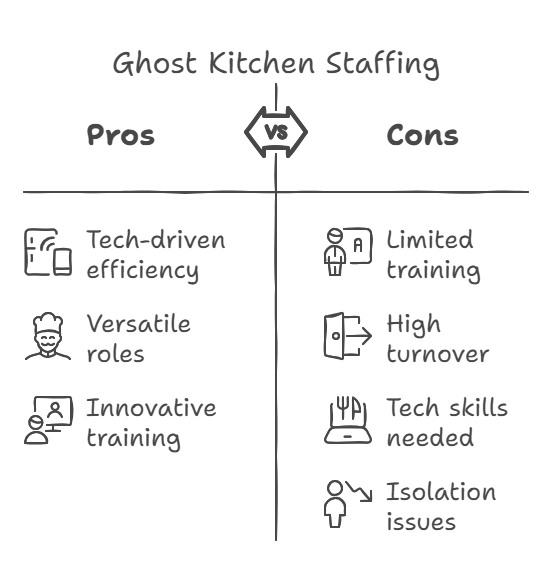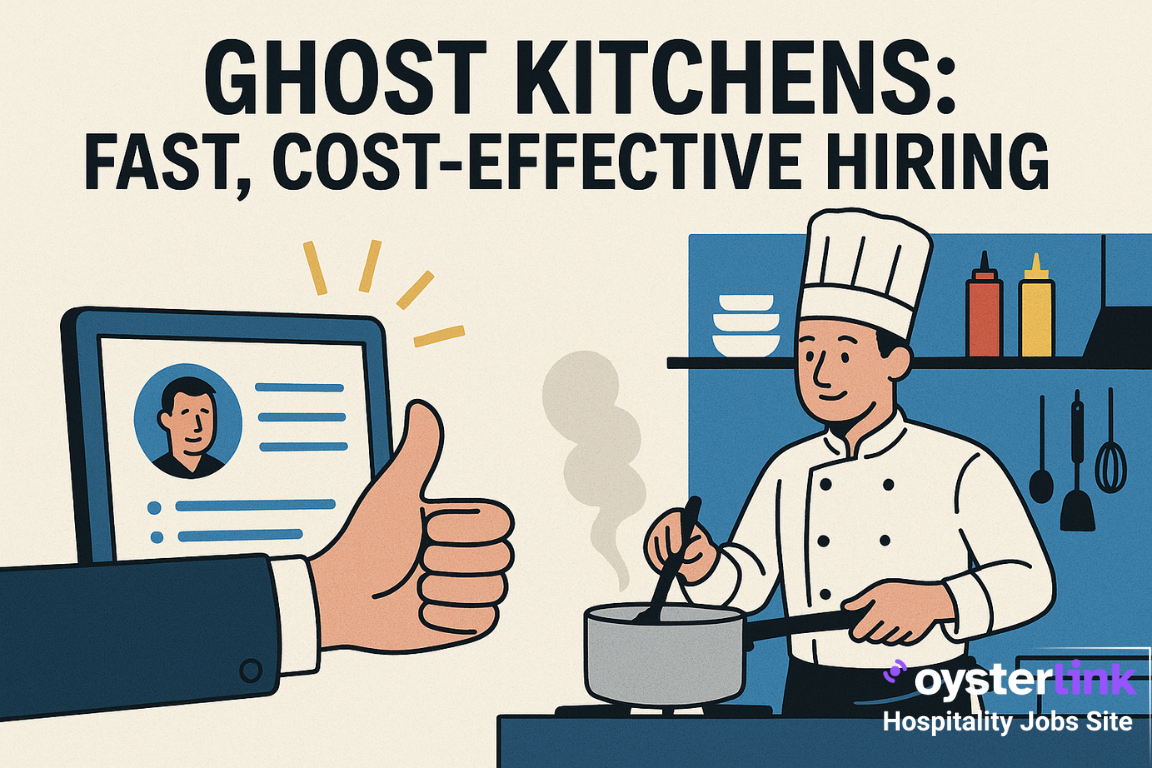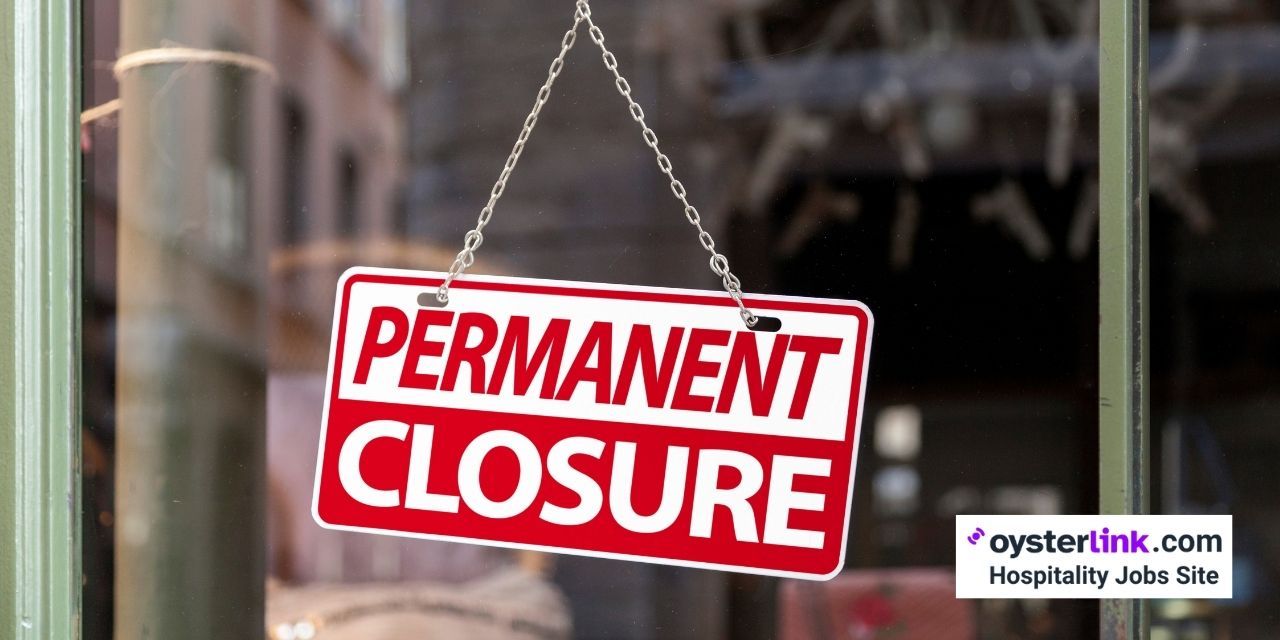Ghost kitchens – delivery-only restaurants with no dining room – have boomed in recent years as the pandemic and food-delivery apps reshaped dining habits These virtual kitchens operate with minimal staff and tight margins, so finding skilled Cooks, packers and managers quickly is crucial.
OysterLink, a hospitality-focused job site, fits this niche. We charge just $50 per job posting and connect employers to a pool of over 400,000 hospitality professionals.
In practice, a ghost kitchen manager can post an opening for a Cook or kitchen assistant and see qualified resumes within a day. This combination of low cost and rapid response helps ghost kitchens hire flexibly and affordably in a fast-moving industry.
Unique Staffing Challenges in Ghost Kitchens
Ghost kitchens face several hiring hurdles that set them apart from typical restaurants. For example:

- Limited In-Person Training: With no dining room and often no staff office, new hires get minimal face time with managers or Chefs. Ghost kitchens often rely on digital training tools, which means learning on the job can be tough. Less supervision can slow down skill development.
- High Turnover: The restaurant industry already has high turnover (around 75% yearly), and ghost kitchens are similar or worse. Fast-paced, “on-demand” work leads some workers to burn out packing orders or jump to better-known brands. Many operators counter this with signing bonuses or referral incentives, but turnover still makes hiring a constant need.
- Lean, Multi-Task Roles: Ghost kitchens “operate with cross-trained generalists,” meaning one Cook does many jobs. Roles that exist in a full-service restaurant (hosts, servers, etc.) are eliminated. This means each worker must be versatile – a Cook may also be a packaging lineworker and a shift lead. Finding such flexible candidates is challenging.
- Tech-Centric Skills: Everything in a ghost kitchen is run through screens – from order systems to inventory. Staff must be comfortable with point-of-sale tablets, delivery apps, and occasionally basic data entry. This “Food 2.0” approach means standard help-wanted ads may miss good candidates; employers need people fluent with modern kitchen tech.
- Isolation and Culture: Unlike a busy restaurant floor, ghost kitchen teams may not see customers or a large staff daily. New hires can feel isolated or disconnected from a brand’s “energy,” making retention harder. Workers rely on virtual communications and scheduled briefings to stay motivated.
All of these factors mean ghost kitchen managers often need to hire faster and more precisely than traditional restaurants do. When a key Cook quits or order volume spikes, a ghost kitchen cannot wait weeks for one candidate to trickle in – they need a targeted solution that delivers candidates ready for this unique environment.
The Ghost Kitchen Model and Staffing Needs
Ghost kitchens exist solely for delivery and takeout. With no diners on-site, they cut costs on dining space and service staff. But they still need a lean back-of-house team.
Ghost kitchens don’t need hostesses, cashiers or waitstaff – instead, the essential positions include Chefs, kitchen managers and sorting or packing staff. In other words, a ghost kitchen typically hires Line Cooks and Prep Workers who can juggle multiple tasks (for example, a Cook who also packs orders).
These streamlined teams must produce many meals quickly and adapt to changing menus. Ghost kitchens often run multiple “brands” from one kitchen, so staff must be versatile.
For example, a Chef might work one shift making burgers and the next shift assembling pizza or salads. In short, the ghost kitchen model demands multi-skilled, flexible back-of-house staff.
This lean staffing model brings unique challenges. Managers must find people who can hit the ground running with little training, and who are comfortable working without a front-of-house team or real-time customer feedback. Technology is deeply integrated – orders come through tablets and apps – so kitchen staff need to be tech-savvy.
In practice, ghost kitchens rely on “cross-trained generalists: Cooks who can pack orders, and packers who can cook”. In other words, each hire must often fill several roles.
OysterLink: A Hospitality-Focused Job Board
OysterLink is built specifically for the hospitality sector. Unlike general job platforms, we filter out the fluff by allowing only restaurant, hotel, catering and event businesses to post jobs. This means each job listing goes only to people who are already experienced (or looking) in food service and hospitality.
This makes us the ideal platform for restaurants and ghost kitchens.

Because OysterLink is niche, every posting is seen by a relevant audience. OysterLink currently reaches over 400,000 professionals each month who are actively seeking hospitality work.
For a ghost kitchen, that means a job ad will hit Cooks, Bakers, Line Chefs, kitchen staff and other service workers – not office clerks or IT technicians.
Furthermore, our social media and newsletter promote new postings to that audience, so a ghost kitchen job stands out.
In contrast, posting a ghost kitchen job on a general site like Indeed or Glassdoor risks filling the posting with applicants from unrelated fields.
On Indeed, for example, millions of jobs are listed, making it easy for a listing to be overlooked.
By using a hospitality-only board, ghost kitchen owners avoid wading through irrelevant applications. Every applicant from OysterLink has restaurant-relevant experience – saving time and making hires quicker.
Industry Hiring Trends
The need for efficient hiring is underscored by current labor trends. The U.S. restaurant and hospitality sector still faces a serious labor shortage, even as business picks up. In early 2024, staffing in the industry was about 3.6% below pre-pandemic levels – roughly 450,000 positions unfilled.
About 80% of operators say they can’t find enough staff, and 62% admit it’s hard to meet current demand. At the same time, nearly half of operators plan to hire more workers in 2024.
In short, demand for kitchen and service workers is high, and competition for talent is intense. Labor costs have also risen (98% of operators report higher labor expenses), so minimizing recruitment spend helps the bottom line.
Ghost kitchens ride this same wave of growth. Industry forecasts expect the ghost kitchen market to expand rapidly – one analysis projects about 7.6% annual growth through 2027. More delivery sales and new ghost concepts mean more hiring needs.
But since ghost kitchens are often small operations, they can’t afford to linger without staff. A one-day vacancy could delay dozens of orders.
That urgency makes OysterLink’s quick turnaround invaluable. Posting on a niche platform lets operators quickly reach Cooks who are actively looking for restaurant work, even when those Cooks are juggling multiple part-time jobs.
With these trends, niche recruiting tools are gaining traction. Just as ghost kitchens innovate with technology (some use AI-driven scheduling and chatbots to manage shifts), they benefit from smart hiring tech.
A targeted board like OysterLink is effectively a tech-enabled shortcut, delivering pre-qualified candidates fast. The upshot: ghost kitchen managers can keep their lean operations staffed without overspending on recruitment.
Conclusion
Ghost kitchens have unique hiring needs: lean staffs, quick fills, and specially skilled kitchen workers. OysterLink’s hospitality-focused platform meets those needs with speed and economy. Employers post jobs for just $50 each and tap into a community of 400,000+ food service professionals.
Compared to general job sites, this means less time weeding out irrelevant applicants and faster access to qualified Cooks, Servers, and kitchen staff. In today’s tight labor market, that can make the difference between meeting demand or missing orders.
By streamlining the hiring process, OysterLink helps ghost kitchen employers stay agile – filling vacancies within hours and keeping their kitchens running smoothly.





